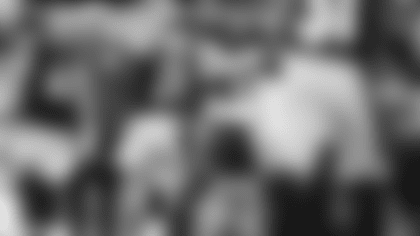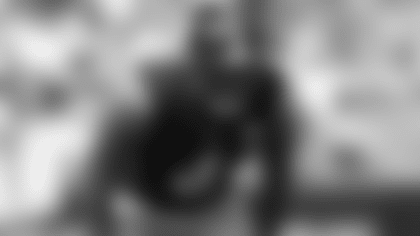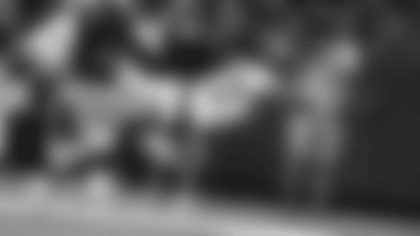Q. I don't know that it would be fair to characterize a 1-2 start in a 17-game season as a tailspin, but it's still not where you want to be. What kind of qualities are required within a group of players and coaches to reverse this?
A. We've just got to continue to get better every day. It is exactly what you said, it's the early juncture of the season, and we have not performed well in some instances, and that has produced a couple of losses. But win or lose this time of year, you've got to clock into work daily and get better. How do we get better? We get better development and understanding of our plans, whatever they may be. Plans get tighter, you get a better understanding or utilization of people, strengths, and weaknesses. You work to lean on the strengths, and you work to minimize the weaknesses. It's reasonable to expect that process to get better as we move forward. It's reasonable to expect players to get better technically. It's routine actions, repetitions, and things of that nature. Young guys like Kendrick Green, like Dan Moore, it's reasonable to expect them to get technically better with each and every passing day. And lastly, they grow in terms of the individual and collective knowledge of the game, particularly as it pertains to situations. And that learning is accelerated, because we're in real situations. It's not scripted situations like you're doing at training camp and team development. We step out of stadiums every week with real experience relative to situational football and the unwritten rules of it. And so, I'm excited about this group getting better each and every day. I don't like where we are, but I'm not wasting a whole lot of time lamenting that. We're rolling our sleeves up daily working to get better. We've had a good week's work this week, but you know how we measure our work – based on performance – and so I'm excited about the opportunity we have today.
Q. What makes you believe you have those kinds of people here?
A. We address that in the player selection process; forget the team development process. I'm talking about every man who wears the black-and-gold has a story. A story of research first by Kevin Colbert and the scouting department, and then collectively by him and me as we travel and do our draft prep and call on that draft prep even years later as we pursue guys in free agency. A guy like Myles Killebrew is new to us, but he's not new to Kevin and me. I remember the interview that Kevin and I had with him in Indy when he came out of Southern Utah when he was just draft eligible. Everybody has a profile, we do our research, we spend time with them, we circle the globe predraft-wise in terms of dining with them, getting to know them getting to know what people say about them at their institutions, etc. All done so we know we have the type of men who are capable of answering the question that you asked.
Q. Last Tuesday at your news conference, you talked about continuing to work to get better, but how do you know when it's time to incorporate some change, either from a personnel standpoint or in terms of schematics?
A. It's just my gut. It's like asking your grandma her recipes. She can't give you her recipe, she just knows when there's enough of this and enough of that in it. I coach from the gut in that perspective, and I always have. I think it's important that you remain open to change when necessary, but you're not so unsteady that you're blowing in the wind. And so that's my general philosophy regarding it.
Q. Is there a Mendoza line when it comes to the individual performances that serve as a signal to you that it's time to make a change?
A. Absolutely.
Q. Is it numbers, statistics that mark the Mendoza Line?
A. You just know when you're there. And I draw that same analogy. Things aren't done in a cookie cutter fashion, decisions aren't made in a cookie cutter fashion. If you're making decisions that way, chances are you're making bad decisions. There are humans in these discussions, there are dynamics in these discussions, there's cohesion related things and in the intangible quality that's associated with team sport. And so, there is no blueprint for any of that.
Q. Last Tuesday you said, "We've got to continually do a better job as a staff to have an understanding of what our strengths and weaknesses are from a personnel standpoint and play to our strengths and minimize our weaknesses." How do coaches minimize a team's weaknesses?
A. You highlight the strengths. You do things to insulate weaknesses, whether it's a personnel weakness, or whether it's a schematic or a matchup weakness. It's our job to forecast it as coaches, and we do, and that's routine business. But boy you've got tangible evidence of some of that stuff as you push into September, win or lose. You just know more about yourselves and each other when you step out of stadiums this time of year. And we'd be remiss if we didn't take that knowledge and information that we're gaining and utilizing it in a better, more comprehensive plan relative to those variables.
Q. You also talked about the necessity of having a tough skin, that you're confident the people you've worked with for a while have it, and that the young ones have to be taught. What do you mean by having a tough skin, and how do you teach young players to have it?
A. I'm not talking about absorbing criticism. Most of these guys played major college football. Pat Freiermuth when he was at Penn State and they got off to a slow start last year, he's got experience in dealing with criticism and the spotlight associated with that. More than anything, I'm talking about the people who are closest to them, the people who are in their corner. People love to provide comfort for those they care about, and I don't want our guys seeking comfort. They have to guard themselves in the spirit around those who care about them the most, because there's nothing to feel bad about. We're capable. There's nothing mystical that goes on in terms of determining the outcome of football games. I got a text from my mom during the week, and she was telling me she was proud of me and all of that. I said, "Hey mom, I appreciate it, but I don't need it. I know what you mean. I have the tools to do the job. There's nothing this business is gonna present me that I can't handle. Worry about something and somebody else." And that's the spirit our guys have to have in terms of how they manage people in their inner circle, and they guard their can-do attitude regarding the adversity that we face. We're capable. We don't have to light candles and have a séance. No, we roll our sleeves up, we go to work, we step back into stadiums, and we play football.
Q. One of the things discussed in the aftermath of the game against the Bengals was "menu of plays." What is a menu of plays, and how many plays are on a menu?
A. If you're talking globally, menus have varying sizes. It depends on the attitude, the spirit of the coaching staff. What I mean is either you're either fundamentalists or your schemers. Fundamentalists tend to have smaller menus; schemers tend to have bigger menus. Schemers can have upwards of 180 plays on the offensive ready-list for a game, knowing that they only will have probably 75 snaps. A fundamentalist may have 120 plays on an offensive game plan. And so, that's the spirit of it.
Q. Are there separate menus for different situations that arise in a game, such as red-zone, goal-line, two-minute?
A. Those plays are broken up into situational elements. You can study analytics and talk about anticipated number of short yardage opportunities, and so chances are you're gonna have 1.5 third-and-1 situations a game. And so, if you have six third-and-1 calls on your ready-list, then you're not practicing smart, as an example. There are a lot of discussions relative to menu. It's been around for a long time, it's very thoughtful and systematic, and you have options in terms of where you swing on the pendulum. Me personally us as an organization we lean more towards being fundamentalists than schemers. But even in the fundamentalist discussion, you're talking about 120 plays on a call sheet in a 75-play game, and so you never seemingly run out of plays. What I'm talking about when I talk about running out of plays is running out of perceived good plays. As the game unfolds, you're looking at those 120 plays, and you call one of them, and maybe it works, maybe it doesn't. If it doesn't work, it might be for schematic reasons or it might be for matchup reasons. You might scratch that play off, but you might scratch off four or five others that are similar to it. And so that's what I mean when I'm talking about looking at a menu and making in-game decisions relative to it.
Q. In the past, we have talked about quarterbacks with "arm talent." Is Aaron Rodgers at the head of that class, and what separates him from some of the others in that conversation?
A. Boy, he's been at the head of that class for a long time, and there are other emerging guys, like Patrick Mahomes in Kansas City. The pinpoint accuracy at any area of the field – short, medium, and long – is one component of it. And the next component of it is to be able to release and deliver the ball from a variety of body positions. Rodgers' athleticism is and always has been underrated; his ability to throw on the move, his ability to throw on the move going to his left with pinpoint accuracy while doing so is freaky. It's no different than a receiver who runs a 4.2 in the 40. It's rare, and to be appreciated.
Q. People talk about franchise quarterbacks and No. 1 receivers. Obviously, Aaron Rodgers is a franchise quarterback. What's a No. 1 receiver, and does Davante Adams have those qualities?
A. A No. 1 receiver is a guy you cannot diminish schematically. You remember when Antonio Brown was in Pittsburgh and on top of his game, each and every week he faced schematics that were created to minimize his impact on the game. But if you were at the games, you saw him routinely dominate games. And the same thing could be said about Davante Adams. You think the San Francisco 49ers had some efforts in place to minimize his ability to get the ball in the waning moments of last week's game? I'm sure the 49ers worked all week on minimizing him, particularly in those situational moments. And with 39 seconds left to go in that game, he went down the field and converted two significant gains, he and Aaron Rodgers, and put them in position to win the game. That's what the No. 1s do.
Q, You have said it's not necessarily realistic to stop a player like Davante Adams, and a more realistic goal is to minimize him. How is minimize defined in your mind? Number of catches? Number of yards?
A. It is particularly in situations, because situations are weighted differently. Possession downs are different than first and second downs, and so guys like Davante Adams carry a lot of weight with them. When I came into the league in the early 2000s, you play the Minnesota Vikings when I was with the Buccaneers, and you're dealing with Randy Moss. You did different things that week. It didn't take two or three snaps, and he could have three catches for 180 yards and two touchdowns on you, and that's gonna change the climate. And so, it's situations first, but those real No. 1s, those unique guys, those guys you compare to when you're talking about the term "franchise quarterback," it's a challenge and it's an every-down challenge.
Q. Over your NFL career, you've been on the visiting sideline a bunch at Lambeau Field. What about it makes it a uniquely different environment for the visiting team?
A. There are a lot of challenging environments, and I'm not taking anything away from Lambeau Field. It is challenging, the fans are passionate, the noise, the team performs well there, and Aaron Rodgers has got a lot of a lot to do with that. For me, the thing that really makes it special is just as a football lover, the nostalgia of it all. I envision Vince Lombardi on that other sideline. I think about historical games that have been played in that venue, contributions made to the game of football, by our forefathers, by those who have come before us that provided opportunities for me and for players who were born out of their labor. I just really appreciate it on that level, I just respect it on that level as a football lover, as somebody who's been in football all my life. When you're in that venue, you're walking down that narrow tunnel with that low ceiling to come out of that end zone, and you realize that stadium was built 100 years ago. That hallway probably was sufficiently big enough 100 years ago, but now players are walking around 6-foot-9, 350. And so, it's cool to watch some of the big people walk that tunnel, and you think about some of the legendary men who have played this game, and the legendary plays that have been made there, and I just appreciate it on that level.














